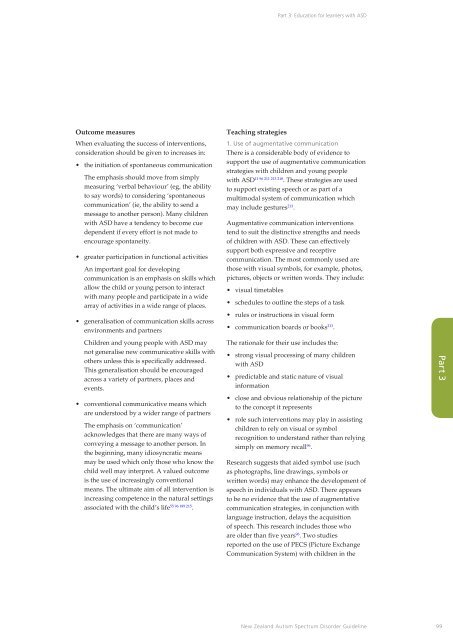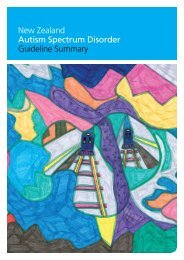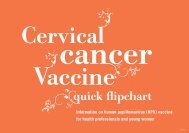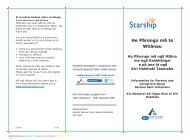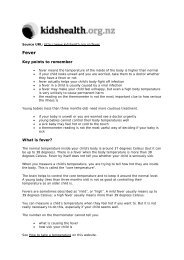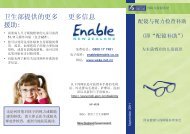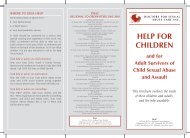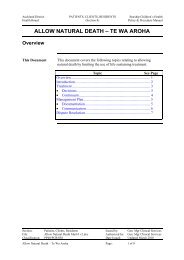New Zealand Autism Spectrum Disorder Guideline - Ministry of Health
New Zealand Autism Spectrum Disorder Guideline - Ministry of Health
New Zealand Autism Spectrum Disorder Guideline - Ministry of Health
Create successful ePaper yourself
Turn your PDF publications into a flip-book with our unique Google optimized e-Paper software.
Part 3: Education for learners with ASD<br />
Outcome measures<br />
When evaluating the success <strong>of</strong> interventions,<br />
consideration should be given to increases in:<br />
• the initiation <strong>of</strong> spontaneous communication<br />
The emphasis should move from simply<br />
measuring ‘verbal behaviour’ (eg, the ability<br />
to say words) to considering ‘spontaneous<br />
communication’ (ie, the ability to send a<br />
message to another person). Many children<br />
with ASD have a tendency to become cue<br />
dependent if every effort is not made to<br />
encourage spontaneity.<br />
• greater participation in functional activities<br />
An important goal for developing<br />
communication is an emphasis on skills which<br />
allow the child or young person to interact<br />
with many people and participate in a wide<br />
array <strong>of</strong> activities in a wide range <strong>of</strong> places.<br />
• generalisation <strong>of</strong> communication skills across<br />
environments and partners<br />
Children and young people with ASD may<br />
not generalise new communicative skills with<br />
others unless this is specifically addressed.<br />
This generalisation should be encouraged<br />
across a variety <strong>of</strong> partners, places and<br />
events.<br />
• conventional communicative means which<br />
are understood by a wider range <strong>of</strong> partners<br />
The emphasis on ‘communication’<br />
acknowledges that there are many ways <strong>of</strong><br />
conveying a message to another person. In<br />
the beginning, many idiosyncratic means<br />
may be used which only those who know the<br />
child well may interpret. A valued outcome<br />
is the use <strong>of</strong> increasingly conventional<br />
means. The ultimate aim <strong>of</strong> all intervention is<br />
increasing competence in the natural settings<br />
associated with the child’s life 55 96 189 215 .<br />
Teaching strategies<br />
1. Use <strong>of</strong> augmentative communication<br />
There is a considerable body <strong>of</strong> evidence to<br />
support the use <strong>of</strong> augmentative communication<br />
strategies with children and young people<br />
with ASD 11 96 211 213 218 . These strategies are used<br />
to support existing speech or as part <strong>of</strong> a<br />
multimodal system <strong>of</strong> communication which<br />
may include gestures 213 .<br />
Augmentative communication interventions<br />
tend to suit the distinctive strengths and needs<br />
<strong>of</strong> children with ASD. These can effectively<br />
support both expressive and receptive<br />
communication. The most commonly used are<br />
those with visual symbols, for example, photos,<br />
pictures, objects or written words. They include:<br />
• visual timetables<br />
• schedules to outline the steps <strong>of</strong> a task<br />
• rules or instructions in visual form<br />
• communication boards or books 213 .<br />
The rationale for their use includes the:<br />
• strong visual processing <strong>of</strong> many children<br />
with ASD<br />
• predictable and static nature <strong>of</strong> visual<br />
information<br />
• close and obvious relationship <strong>of</strong> the picture<br />
to the concept it represents<br />
• role such interventions may play in assisting<br />
children to rely on visual or symbol<br />
recognition to understand rather than relying<br />
simply on memory recall 96 .<br />
Research suggests that aided symbol use (such<br />
as photographs, line drawings, symbols or<br />
written words) may enhance the development <strong>of</strong><br />
speech in individuals with ASD. There appears<br />
to be no evidence that the use <strong>of</strong> augmentative<br />
communication strategies, in conjunction with<br />
language instruction, delays the acquisition<br />
<strong>of</strong> speech. This research includes those who<br />
are older than five years 96 . Two studies<br />
reported on the use <strong>of</strong> PECS (Picture Exchange<br />
Communication System) with children in the<br />
Part 3<br />
<strong>New</strong> <strong>Zealand</strong> <strong>Autism</strong> <strong>Spectrum</strong> <strong>Disorder</strong> <strong>Guideline</strong> 99


